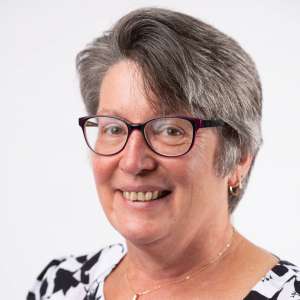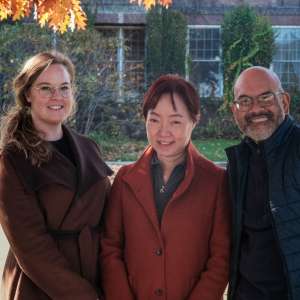Karen Heikkilä: Keene State’s Peripatetic Professor of Place

This year, Keene State College is honored to host a distinguished visiting scholar, Dr. Karen Heikkilä, who is working in the Orang Asli Archive in Mason Library. The collection is among the best in the world for the study of the Orang Asli, which means “Original People” of Peninsular Malaysia.
Dr. Heikkilä’s path to Keene is a window into her journey of place, time and scholarly attainment: She was born in Malaysia; is Canadian; taught in Mongolia and Tajikistan after earning two undergraduate degrees at the University of British Columbia; worked in the Canadian Arctic while completing her Master’s at the University of Northern British Columbia; and finally, settled in Finland, where she earned a PhD at the University of Helsinki.
Her research with a Canadian First Nations group, Tl’azt’en Nation, is where her academic work began with indigenous cultures; this later served as inspiration for her doctoral research with the Semai Orang Asli of Malaysia. Having completed ethnographic fieldwork with the Semai and short stints at the National Archives of Malaysia, Dr. Heikkilä is now in Keene working on Robert Knox Dentan’s anthropological records on the Semai culture, which date back to the 1960s.
Dr. Heikkilä’s work lies at the intersection of geography, linguistics and anthropology. Her specific interest is toponymy, the study of place names and what they reveal about history, culture, territoriality, and the environment. Her travels and research have strengthened her conviction that indigenous place names not only carry geographical information but are important historical and spiritual markers unique to each culture.
Talking to Dr. Heikkilä, one senses that her heart lies with the Semai, one of eighteen groups within the Orang Asli indigenous peoples of Peninsular Malaysia.
“One of my earliest memories,” she recounted recently, “is from a drive with my father and siblings in Malaysia, and seeing two Semai emerge from the forest, carrying a deer balanced on a long pole.”
She went on:
“If you look at satellite photos of the Perak–Pahang border, you will see an unbroken swathe of forest, what Bob Dentan, the first scholar to have worked with the Semai over several decades, called ‘the green and beautiful world’ of the Semai homeland,” she explained.
Within that hilly landscape is an ancient, highly localized, and forest-dependent culture.
“The forest is a vital part of Semai identity,” Dr. Heikkilä said, “and the Semai language and place names articulate their spirituality and ancestral wisdom, their detailed knowledge of medicinal and nutritious plants, location of forest trails, and practical know-how.”
One example of historical information — in this case, shared trauma — conveyed in a place name is a certain rock in the forest whose name in Semai means whetting stone. It refers, she explained, to the place where, centuries ago, Malay-speaking slave raiders, using that very rock to sharpen their machetes, captured Semai women and children and killed many tribe members. That horrifying event is memorialized in the rock’s name and its location.
It is Keene State’s and Dr. Heikkilä’s good fortune that the Dentan papers — boxes and boxes of his field notes, photographs, videos, and artifacts — are housed in the Orang Asli archives. A Wenner-Gren grant secured by Keene State professor emerita Rosemary Gianno and other Orang Asli scholars, helped to bring the Dentan papers and other collections to Keene State.
A symposium in Keene in 2014 drew Orang Asli researchers from around the world to share new and ongoing research, project updates, and to network.
“I received a grant to come to KSC in 2014 but went to Malaysia instead on another grant for some data-verification work, but now I’m finally here,” Dr. Heikkilä said.
What she hopes to accomplish in the archive, in addition to reviewing and discovering connections in the impressive volume of material, is to identify areas of future research.
“The Dentan papers have filled in many blanks for me and provided clues to understanding land tenure patterns and settlement history among the Semai,” she said.
She believes place names are an important facet of Semai oral tradition, containing irreplaceable information about forest ecology, local history, spiritual practices, and other cultural features that have survived over time.
“Many Semai communities still have their forest homelands to live in and this supports their indigeneity,” she maintains.
There is much to learn from the Semai’s peaceable society and what Dr. Heikkilä describes as its conservation ethic: “Take what is available, only as much as you need, and share with others.”
The Robert Knox Dentan Collection stands as an example of a repository of written information about an indigenous community’s past, as it was lived and known by its ancestors. It is Dr. Heikkilä’s hope that more scholars and students will use the collections housed at the Orang Asli Archive, in preparation for field research or for more advanced scholarly study on aspects of Orang Asli languages, cultures, and livelihoods.
There is still much to do, she noted, in terms of documenting Semai traditional knowledge of trees and other plants, their geographical lexicon, and the way peace and ecologically sustainable principles guide how their communities live in the world.
So, it is no wonder that when Dr. Heikkilä leaves Keene State later this year, she hopes her next stop will be Malaysia.





